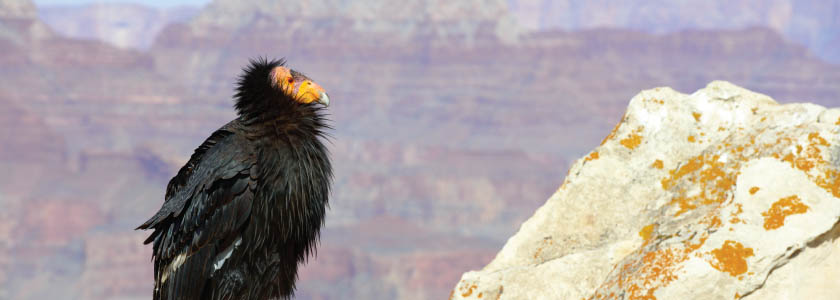The California condor regains its habitat—but genetic depression remains

The California condor is the largest flying bird in North America, with a wingspan of nearly 10 feet. They typically feed on carrion, can weigh up to 26 pounds, and can live for more than a half-century. Black, with patches of white and a bald, reddish head, the bird is not what you’d necessarily call pretty—until you see them fly. They can stay aloft for hours, soaring up to 15,000 feet on warm air thermals, gliding at speeds of up to 55 miles per hour in huge arcs across the sky.
Condors once ranged across much of North America, though by 1492 their habitat had withdrawn to cover the West Coast and the American Southwest. Condor numbers fell drastically beginning in the 1900s due to poaching, habitat destruction, DDT poisoning, electric power lines, egg collecting, and lead poisoning. By 1985 there were just 9 left in the wild, and they were plucked from their cliffside perches and sequestered into zoos and research facilities for what would become one of America’s most ambitious, and expensive, captive breeding and rehabilitation projects.
Oklahoma City Zoo and the San Diego Wild Animal Park
In places like the Oklahoma City Zoo and the San Diego Wild Animal Park, rehab custodians were at first stymied in their efforts to grow the condors’ population due to mating habits, but soon hit on a solution: they removed the first egg from each nest and raised it with condor-like hand puppets while the female laid another egg. The program worked. In 1988, a handful of female Andean condors were temporarily released into the wild in California to see how a reintroduction could take place and, beginning in 1991, California condors were released into the wild in California and Arizona.
Rehabilitation worked, albeit slowly. In 2001, the first nestling fledged in the wild since 1981, and in 2006 condors returned to Northern California. Condors were later reintroduced into Mexico, and by 2016 the wild population in the US was estimated at 276. Then, in May 2020, two were spotted in Sequoia National Park, a sighting seen as a significant milestone in the birds’ recovery.
While the species’ recovery has been a success, there is one fact that can’t be overlooked: the condors alive today descend from just a handful of survivors. This represents a significant genetic bottleneck, leaving the animals with little genetic variation.
Although the headline-grabbing decline of the birds in recent decades certainly did not help, a 2016 study in The Condor: Ornithological Applications, found that there had been more than an 80% reduction in unique haplotypes over the last 200 years. In that study, researchers took DNA from museum specimens collected beginning in 1825 and compared them to the DNA from species survivors in a San Diego zoo.
“Haplotypes of low frequency were lost when California Condors experienced a major range contraction and reduction in population size,” the authors noted. “The small number of haplotypes remaining in the California Condor is similar to values reported for other bird species that have gone through a severe population bottleneck, including the Whooping Crane (Grus americana) Crested Ibis (Nipponia nippon), and Pink Pigeon (Streptopelia mayeri).”
While the mitochondrial DNA haplotype diversity was low in California condors, the same is true in other large raptors, the authors added, including the Andean condor, Spanish eagle, White-bellied sea eagle, and others. The reasons are likely all the same: population bottlenecks followed by a long recovery.
More recently, scholars have delved more deeply into short-read and long-read DNA-Seq data.
Will the California Condor Bounce Back?
California condors can bounce back, researchers think, but despite the ongoing recovery of their geographic range, the species will need a helping hand for years to come.
“The genetic bottleneck resulted in inbreeding and decreased fitness, and condors will continue to require intensive management for some time to recover,” notes Science Daily. “But there is a possible upside for condor conservation in the results of this study—(researchers) did not find any evidence that the now-vanished Pacific Northwest population was genetically isolated from the condors in California. If Northwest condors weren't on a separate evolutionary track, there's no reason not to release today's captive-bred condors into those unoccupied areas of their historical range.”
